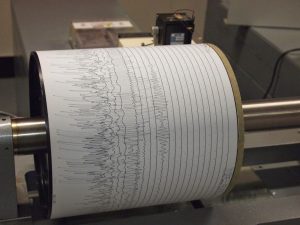
There is an enduring myth that large earthquakes tend to happen during certain phases of the Moon or at certain times during the year. But a new analysis published in Seismological Research Letters confirms that this bit of earthquake lore is incorrect.
After matching dates and lunar phases to 204 earthquakes of magnitude 8 or larger, Susan Hough of the U.S. Geological Survey concluded that there is no evidence that the rates of these great earthquakes are affected by the position of the Earth relative to either the Moon or the Sun.
In fact, the patterns that some observers see as linking large earthquakes with specific parts of the lunar cycle “are no different from the kinds of patterns you would get if the data are completely random,” Hough noted.
To determine this, Hough looked at both the day of the year and the lunar phase for 204 large earthquakes from the global earthquake catalog, dating back to the 1600s. To avoid detecting clusters of earthquakes within the data that are related to other factors, she chose to look at larger earthquakes because they are less likely to be an aftershock of a bigger earthquake.
Looking at only large earthquakes also allowed Hough to pare down the list to a manageable number that could be matched to lunar phase information found in online databases.
Her analysis did turn up some clusters of earthquakes on certain days, but to test for any significance in the patterns she was observing, she randomized the dates of the earthquakes to find out what kind of patterns would appear in these random data. The patterns in the random data were no different from the kinds of patterns showing up in the original data set, she found.
This isn’t an unusual finding, Hough noted. “When you have random data, you can get all sorts of apparent signals, just like when you flip a coin, you sometimes end up with five heads in a row.”
Hough did see some unusual “signals” in the original data; for instance, the highest number of earthquakes (16) occurring on a single day came seven days after the new moon. But this signal was not statistically significant, “and the lunar tides would be at a minimum at this point, so it doesn’t make any physical sense,” she noted.
Hough said that the Moon and Sun do cause solid Earth tidal stresses — ripples through the Earth itself, and not the waters hitting the coastline — and could be one of the stresses that contribute in a small way to earthquake nucleation.”
Some researchers have shown that “there is in some cases a weak effect, where there are more earthquakes when tidal stresses are high,” she said, “But if you read those papers, you’ll see that the authors are very careful. They never claim that the data can be used for prediction, because the modulation is always very small.”
The idea that the Sun and Moon’s positions in the sky can modulate earthquake rates has a long history, she said. “I’ve read Charles Richter’s files, the amateur predictors who wrote to him in droves, because he was the one person that people knew to write to … and if you read the letters, they’re similar to what people are saying now, it’s all the same ideas.”
“Sooner or later there is going to be another big earthquake on a full moon, and the lore will pop back up,” said Hough. “The hope is that this will give people a solid study to point to, to show that over time, there isn’t a track record of big earthquakes happening on a full moon.”
Note: The above post is reprinted from materials provided by Seismological Society of America.










